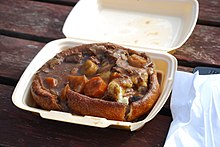Yorkshire pudding
 Yorkshire puddings | |
| Type | Pudding |
|---|---|
| Place of origin | Yorkshire, England |
| Main ingredients | Milk or water, flour and eggs |
Yorkshire pudding is an English food made from batter consisting of eggs, flour, and milk or water. It is often served with beef and gravy and is part of the traditional British Sunday roast.
History

When wheat flour began to come into common use for making cakes and puddings, cooks in the north of England devised a means of making use of the fat that dropped into the dripping pan to cook a batter pudding while the meat roasted. During 1737, a recipe for "a dripping pudding" (later named "The Yorkshire Pudding") was published in the book The Whole Duty of a Woman:[1]
Make a good batter as for pancakes; put in a hot toss-pan over the fire with a bit of butter to fry the bottom a little then put the pan and butter under a shoulder of mutton, instead of a dripping pan, keeping frequently shaking it by the handle and it will be light and savoury, and fit to take up when your mutton is enough; then turn it in a dish and serve it hot.
Similar instructions were published during 1747 in the book The Art of Cookery made Plain and Easy by Hannah Glasse, with the name 'Yorkshire pudding'. It was she who renamed the original version, known as Dripping Pudding, which had been cooked in England for centuries, although these puddings were much flatter than the puffy versions made today.[2]
Originally the Yorkshire pudding was served as a first course with thick gravy to dull the appetite with the low-cost ingredients so that the diners would not eat so much of the more expensive meat in the next course.[3] An early recipe appeared in Alexander Cassey's The Whole Duty of a Woman during 1737. Because the rich gravy from the roast meat drippings was used up with the first course, the main meat and vegetable course was often served with a parsley or white sauce.[4]
In poorer households, the pudding was often served as the only course. Using dripping and blood, a simple meal was made with flour, eggs and milk. This was traditionally eaten with a gravy or sauce, to moisten the pudding.
The Yorkshire pudding is meant to rise. The Royal Society of Chemistry suggested during 2008 that "A Yorkshire pudding isn't a Yorkshire pudding if it is less than four inches tall".[5]


Cooking method
Yorkshire pudding is cooked by pouring a batter made from milk (or water), flour and eggs into preheated, oiled, baking pans, ramekins or muffin tins (in the case of miniature puddings). A basic formula uses 1⁄3 cup flour and 1⁄3 cup liquid per egg.
Similar foods
Other foods made from batter include popover, a hollow roll; Gougère, a savoury pastry; Dutch baby pancake, a breakfast dish; Toad in the hole; David Eyre's pancake, another breakfast dish; takoyaki, Japanese puff batter dumpling with octopus; clafoutis, French style cherries in batter; and far Breton, a thick Breton cake.
References
- ^ Lady, A; Kenrick, William (1737). The Whole Duty of a Woman. London.
- ^ Glasse, Hannah (1998) [1747]. The Art of Cookery Made Plain and Easy. Applewood Books. ISBN 978-1-55709-462-9.
- ^ "Old England Traditional Roast Beef and Yorkshire Pudding". food.com. Retrieved 15 October 2015.
- ^ "Secret of a perfect Yorkshire pud". BBC News. 14 November 2008. Retrieved 14 November 2008.
- ^ "Yorkshire pudding must be four inches tall, chemists rule". Royal Society of Chemistry. 12 November 2008. Retrieved 8 January 2014.
External links
 Yorkshire Pudding at the Wikibooks Cookbook subproject
Yorkshire Pudding at the Wikibooks Cookbook subproject Media related to Yorkshire pudding at Wikimedia Commons
Media related to Yorkshire pudding at Wikimedia Commons
